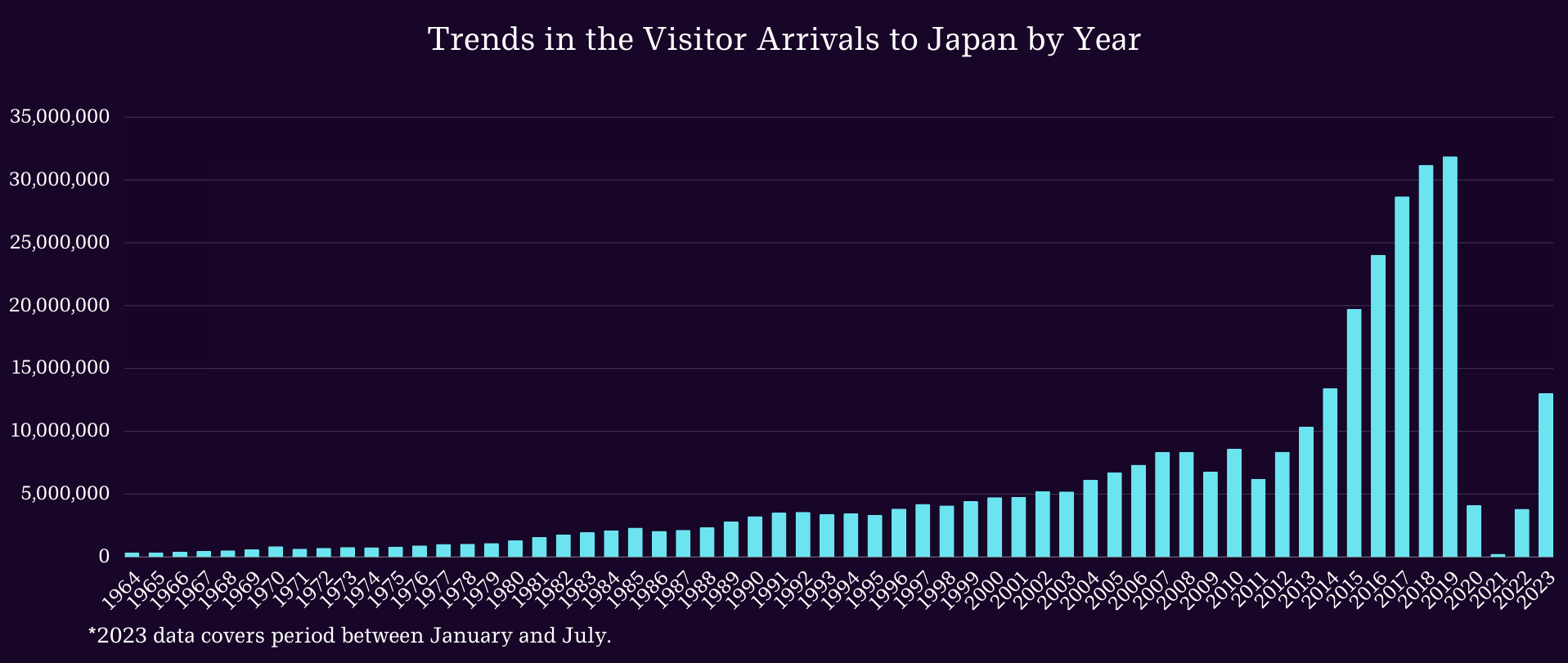Insights >
Tourism in Japan – latest trends and 2024 predictions


New: 2024 Japanese Consumer Behaviour | Whitepaper | download for FREE >>


Tourism in Japan has swiftly recovered since reopening borders in 2022, bouncing back faster than expected after the pandemic.
The article explores the reasons behind this resurgence and provides insights into trends we can expect in 2024.
Japan initially restricted travel from China’s Hubei Province in 2020 and gradually expanded the ban. In December 2020, the country closed its borders to all nonresident foreign nationals. A full reopening occurred on October 11, 2022, with vaccine and documentation requirements lifted in April 2023.
Japan experienced a rapid recovery after reopening. In January, there were 1.5 million international arrivals (44% less than in 2019). By August, the deficit had reduced to 14%. Bookings for luxury hotels are on a steady upward trajectory.
The experts anticipate Japan to recover by 2024 and surpass 2019 levels soon after.
 Source: JNTO
Source: JNTO
Tourists now seek a deeper understanding of Japan, moving away from traditional sightseeing.
Destinations like Kyoto have embraced sustainable tourism, and iconic sites like Mount Fuji may consider restricting the number of visitors.
 Source: JNTO
Source: JNTO
In 2023, over 28% of visitors to Japan came from South Korea. Taiwan comes in second with 16.8%, and the US is third with 9%.
 Source: JNTO
Source: JNTO
In 2023, a vast majority – over 95% of the total number of visitors – came to Japan as tourists.
 Source: JNTO
Source: JNTO
Read about 2023 advertising trends in APAC →
The pandemic brought several positive changes. Japan has become more visitor-friendly, with a positive attitude shift toward international visitors.
The Japanese government also launched various initiatives aimed at further boosting national tourism.
This plan aims to improve Japan’s tourism and address the economic damage caused by the pandemic.
The Ministry of Economy, Trade and Industry (METI) has published the Smart Resort Handbook. It provides guidance on using DX to attract visitors, promote consumption, and enhance productivity and sustainability.
Kyoto uses AI to analyze data and manage over-tourism by forecasting traffic congestion. It also adapts to the “new form of travel” with virtual tours and advanced hygiene management.
The Japanese government also uses information and communication technology for public relations, tourism promotion, and stimulating domestic and inbound tourism.
The Japan National Tourism Organization (JNTO) has been working on making it easy for international travellers to access information about Japan.
On top of moving away from traditional media towards digital communication tools, the new strategy includes the following:
The Japanese government annually revises the consumption tax exemption system to meet user and business needs.
The 2020 amendment eliminates the need for staff to grant tax exemption on goods sold through vending machines. Tax exemption is now based on facial and optical recognition. This streamlines the process without requiring a passport check.
The Japanese government is working on providing multilingual support for the increasing number of foreign tourists visiting Japan.
A comprehensive multilingual information-sharing system has been established at airports, public transportation, and tourist attractions.
The rule that only licensed tour-guide interpreters can work has been removed. This change addressed two issues: language support and the shortage of workers in Japanese hotels.
Individuals without formal certification can provide tour guide and interpreter services for a fee. This aims to increase the number of available tour guides and interpreters while maintaining a certain quality standard.
According to the Japan National Tourism Organisation (JNTO), the estimated number of international travellers to Japan in July 2023 was 2,320,600. It is a 1,505.1% increase from the same month of the previous year, exceeding 2 million for the second consecutive month.
 Source: The Japan Times
Source: The Japan Times
Since the annual climbing season opened in July, around 65,000 hikers have reached the summit – an increase of 17% from 2019. Rubbish on trails, rising CO2 emissions and reckless hikers are among the reasons officials fear the environmental situation has reached a “critical point.”
 Source: Pixabay
Source: Pixabay
Many Japanese islands have introduced an “entrance tax” on visitors to curb overcrowding. From October, visitors to the island of Miyajima, home to the World Heritage site of Itsukushima Shrine will have to pay a JPY 100 fee (USD 0.64). The city anticipates the new tax will bring in JPY 140m (USD 960k) in FY23.
Japan Railway Group has raised prices for rail passes for the first time in four decades, with an average increase of 70%. This includes a 14-day unlimited travel pass, which now costs ¥80,000 ($534), up from ¥47,250. Despite the significant price hike, demand is expected to remain strong, partly due to a cheaper yen and a steady flow of inbound tourists.
Japan Tourism Agency (JTA) wants more budget in 2024 to boost tourism and implement its revival and promotion initiatives.
The key focus areas include:
 Source: Travel Voice
Source: Travel Voice
Are you considering launching a business in Japan? Our team of bilingual Japanese digital marketers are here to support you.
We are a digital marketing agency offering services like consultation, website localisation, social media marketing and SEO.
We have an extensive list of contacts and partner companies in the APAC region to help you enter the Asian markets.
 Contact us at DMFA to discuss opportunities.
Contact us at DMFA to discuss opportunities.
Simply fill in the form and our team will get back to you as soon as possible →